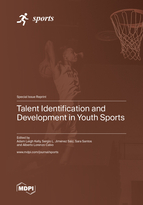Talent Identification and Development in Youth Sports
A special issue of Sports (ISSN 2075-4663).
Deadline for manuscript submissions: closed (3 June 2023) | Viewed by 163790
Special Issue Editors
Interests: talent identification and development; athlete development and youth sport; birth advantages and the relative age effect; sports psychology and coaching
Special Issues, Collections and Topics in MDPI journals
Interests: talent development; coach development; sport performance; performance analysis in basketball; strength training
Interests: talent development; creativity development in team sports and performance analysis
Special Issues, Collections and Topics in MDPI journals
Special Issue Information
Dear Colleagues,
How do talented children achieve expertise at adulthood? The identification of young athletes with the potential to develop and then subsequently excel as senior professionals in their specialist sport remains one of the major contemporary challenges for national governing bodies, sports clubs, coaches, and practitioners. As such, talent identification and development strategies have become pivotal to sporting organisations. Indeed, the complexity of the process of nurturing youth through development trajectories towards adulthood has been enhanced over recent years, with the implementation of modern multidisciplinary paradigms becoming increasingly prevalent in youth sport settings.
With this Special Issue, we seek to collaborate with researchers within the discipline of talent identification and development in youth sport. More specifically, the overarching aim is to explore how youth’s personal engagement in activities (i.e., the what), quality social dynamics (i.e., the who), and appropriate settings and organisational structures (i.e., the where) can foster immediate, short- and long-term developmental outcomes (see the Personal Assets Framework by Côté et al., 2014, 2016). In doing so, it is hoped that contributing research can inform evidence-based youth sport policies and athlete development programmes. Submissions are encouraged from a diverse range of qualitative and quantitative data collection procedures to explore the current context of talent identification and development in youth sport. In addition, commentaries, conceptual papers, and reviews are welcome to synthesise expert knowledge within this discipline.
Potential topics include, but are not limited to, the following:
- Athlete development pathways (e.g., early specialisation; early sampling)
- Birth advantages and the relative age effect (e.g., birthplace effects; socioeconomic factors)
- Growth, maturation, and physical development (e.g., biological age; fitness testing)
- Psychological characteristics (e.g., leadership; mental toughness)
- Perceptual–cognitive expertise (e.g., tactical decision making; virtual reality)
- Technical development (e.g., skills testing; performance analysis)
- Positive youth development (e.g., influence of family, peers, and coaches; youth sport dropout)
- Creating enriching environments (e.g., creativity-based programmes; teaching models)
- Multidisciplinary approaches to athlete development (e.g., holistic approaches; multidisciplinary models)
- Qualitative research exploring key stakeholder experiences and perceptions of the talent identification and development processes in youth sport (e.g., interviews; focus groups)
- Opinions and reviews to synthesise expert knowledge (e.g., conceptual papers; systematic reviews)
Please feel free to contact the editorial team directly if you wish to discuss a potential submission.
Dr. Adam Leigh Kelly
Dr. Sergio L. Jiménez Sáiz
Dr. Sara Diana Leal dos Santos
Dr. Alberto Lorenzo Calvo
Guest Editors
Manuscript Submission Information
Manuscripts should be submitted online at www.mdpi.com by registering and logging in to this website. Once you are registered, click here to go to the submission form. Manuscripts can be submitted until the deadline. All submissions that pass pre-check are peer-reviewed. Accepted papers will be published continuously in the journal (as soon as accepted) and will be listed together on the special issue website. Research articles, review articles as well as short communications are invited. For planned papers, a title and short abstract (about 100 words) can be sent to the Editorial Office for announcement on this website.
Submitted manuscripts should not have been published previously, nor be under consideration for publication elsewhere (except conference proceedings papers). All manuscripts are thoroughly refereed through a single-blind peer-review process. A guide for authors and other relevant information for submission of manuscripts is available on the Instructions for Authors page. Sports is an international peer-reviewed open access monthly journal published by MDPI.
Please visit the Instructions for Authors page before submitting a manuscript. The Article Processing Charge (APC) for publication in this open access journal is 1800 CHF (Swiss Francs). Submitted papers should be well formatted and use good English. Authors may use MDPI's English editing service prior to publication or during author revisions.
Keywords
- talent development
- talent identification
- talent pathway
- expertise
- long-term athlete development
- relative age effect
- cultural factors
- early specialisation
- performance analysis










